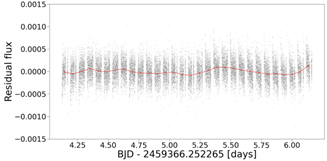By using oscillations of stars we can explore the inner structure of stars, such as geophysicists use earthquake waves to map the interior of planet Earth. Stars showing pulsations are ideal to measure cosmic distances and to study the Galactic structure and evolution. Our research group works with space telescopes (CoRoT, Kepler/K2, TESS, Gaia, CHEOPS, PLATO), as well as ground-based instruments to study stellar pulsations and oscillations. The SPEX group has a long tradition in theoretical modeling of stellar structure and evolution, convection, and pulsation physics. We also study exoplanets in distant solar systems, and are participants in large sky surveys, like WEAVE and Rubin Observatory’s LSST. Recently we have started to develop image based classification algorithms using machine learning techniques. These algorithms mimic those processes that happen in the human brain during recognizing different variable star classes.
The webpage of the group can be found here.
Webpage of the SeismoLab research group led by László Molnár that's part of the SPEX group.
- three important results:
1. Detailed investigation of a debris disk around a binary system
Boldog, Á., Szabó, M. Gy., Kriskovics L. et al. Glancing through the debris disk: Photometric analysis of DE Boo with CHEOPS, Astronomy & Astrophysics, Volume 671, id.A127, 10 pp. 2023, https://ui.adsabs.harvard.edu/abs/2023A%26A...671A.127B/abstract


Left: ESA’s CHEOPS space telescope (credit: ESA/ATG medialab). Right: irregular light variations in the DE Boo system after removing all known variability sources (source: Boldog et al. A&A 671, A127, 2023)
DE Boo (HR 5553) is a unique spectroscopic binary system at a distance of 38 light years, with an edge-on debris disk around the binary. This is the closest known system with a debris disk, which is analogous to the Kuiper belt in the Solar System. Four days of high photometric precision of the Characterising Exoplanet Satellite (CHEOPS) provided an exceptional opportunity to observe small variations in the light curve due to transiting material in the disk. The photometric observations were accompanied by spectroscopic measurements with the 1m RCC telescope at Piszkéstető Observatory and with the SOPHIE spectrograph in order to refine the astrophysical parameters of DE Boo. We report the presence of nonperiodic transient features in the residual light curves with a transit duration of 0.3–0.8 days. We calculated the maximum distance of the material responsible for these variations to be 2.47 AU from the central star, much closer than most of the mass of the debris disk. We interpreted the transient features as the result of scattering in an inner debris disk around DE Boo due to interactions between planetesimals. Furthermore, we report the first observation of flaring events in this system.
2. First Cepheid observations of TESS
Plachy, E., Pál., A., Bódi, A. et al. TESS Observations of Cepheid Stars: First Light Results, The Astrophysical Journal Supplement Series, Volume 253, Issue 1, article id. 11, 24 pp. 2021, https://ui.adsabs.harvard.edu/abs/2021ApJS..253...11P/abstract
We presented the first analysis of Cepheid stars observed by the TESS space mission. Our sample consists of Cepheid 25 pulsators. The targets were chosen from fields with different stellar densities, both from the Galactic field and from the Magellanic System. Our main goal was to explore the potential and the limitations of TESS concerning the various subtypes of Cepheids. We detected many low-amplitude features: weak modulation, period jitter, cycle-to-cycle changes and timing variations due to light-time effect. We also reported signs of nonradial modes and the first discovery of such a mode in an anomalous Cepheid.
Cepheids around the Magellanic Clouds in TESS Sectors 1 & 2 (Source: Plachy et al. ApJS, 253, A11, 2021)
3. Mesterséges intelligencia alkalmazása nagy égboltfelmérések esetében.
Szklenár T., Bódi A., Tarczay-Nehéz, D. és mások, Image-based Classification of Variable Stars: First Results from Optical Gravitational Lensing Experiment Data, ApJL, 897, L12, 2020 https://ui.adsabs.harvard.edu/abs/2020ApJ...897L..12S/abstract
Szklenár T., Bódi A., Tarczay-Nehéz, D. és mások, Variable Star Classification with a Multiple-input Neural Network ApJL, 897, L12, 2022
https://ui.adsabs.harvard.edu/abs/2022ApJ...938...37S/abstract
In the framework of the Near-field cosmology with pulsating variable stars: a Petascale challenge Lendület project we developed a machine learning based, deep convolutional network algorithm to classify light curves of variable stars. We used data from the OGLE sky survey for training. The novelty of our approach is the application of an image-based classification, as opposed to the usage of purely mathematical quantities that describe the light curves. Our method works similarly to the human brain: first it learns the larger scale structure and then it turns to the finer details. In the next step we added the period and other quantities to improve the methods which help in lifting the existing degeneracies in RR Lyrae and anomalous cepheid light curves. We hope that the method will be used in large sky surveys carried out from the ground or from space.


Left: Illustration for application of machine learning methods for variable star classification. We employed image-based algorithms that mimic the human brain. Right: the light curve images used in the model (Source: Szklenár et al. 2020).
